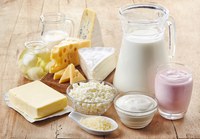Prairie Fare: Let’s Have a Toast to Milk During National Dairy Month
(Click an image below to view a high-resolution image that can be downloaded)
-

This recipe features a lot of common ingredients in the refrigerator. (Photo courtesy of the Midwest Dairy Council) -

Explore your milk, cheese and yogurt options during June, National Dairy Month. (Photo courtesy of the Midwest Dairy Council) -

Julie Garden-Robinson, NDSU Extension food and nutrition specialist (NDSU photo) -

Prairie Fare graphic identifier
By Julie Garden-Robinson, Food and Nutrition Specialist
NDSU Extension
“You have a lot of food in here,” our son commented the other day.
He was investigating the contents of our refrigerator.
“Eat whatever you like,” I remarked.
He is all grown up, but he still checks what’s in the fridge when he drops by our home.
When our son was a teenager, he’d open our refrigerator every hour, or so it seemed. I’d wonder if he was expecting some miraculous change.
“There’s nothing to eat,” he’d say sometimes. He’d pour a glass of milk and look for cookies in the cupboard.
Usually the food in our refrigerator or nearby cupboard involved some sort of preparation.
He has become less picky with the passage of time.
Do you have certain foods that usually are in your refrigerator?
We have some standbys: milk, cheese, eggs, yogurt, fruit juice, various condiments, meat thawing for dinner, and usually some kind of leftovers.
During June, which is National Dairy Month, explore your milk, cheese and yogurt choices at the grocery store.
If you drink milk, do you have a certain type you prefer? Most of the time, we can choose from whole, 2%, 1% or fat-free (skim).
When I was young, we always had whole milk. That means it has about 3.25% fat by weight. We later had 2% milk as my family changed with the times. Now I usually buy skim milk for my family.
Our daughters enjoy whole milk with chocolate syrup as a treat now and then.
You might see “organic milk” as a choice at the grocery store. This designation means the cows were raised according to U.S. Department of Agriculture farming practices. No distinct nutritional differences exist between organic and traditional milk.
At 8 grams per cup, any type of dairy milk is a notable source of protein to build and maintain our muscles. You might see “ultra-filtered” milk in some stores. This typically has higher protein levels.
Nutritionally, milk with a higher fat percentage has more calories. A cup of whole milk has 149 calories, while a cup of skim milk has 83 calories, according to U.S. Department of Agriculture data.
All types of milk have about the same amount of calcium and are fortified with vitamins D and A. Fortified means the nutrients are added for nutritional reasons. Vitamin D and calcium work together to promote strong bones and teeth, among their many functions. Vitamin A promotes healthy skin, eyes and the functioning of our immune system.
Milk provides many additional minerals and vitamins naturally, including phosphorus, potassium, riboflavin and vitamin B-12.
Some people do not or cannot drink milk for various reasons. People who follow a vegan diet avoid animal products of all types. “Lacto-vegetarians” consume dairy products. “Lacto” refers to lactose, the sugar in milk.
Other people have allergies to the protein in milk and can experience severe reactions. All nutrition labels are required to list any allergens right below the ingredient statement on labels.
Those with lactose intolerance experience gastric upset because their body lacks the enzyme lactase needed to digest the natural milk sugar lactose. Researchers have found that some people with lactose intolerance may be able to consume smaller amounts of milk with meals. They could try yogurt or hard cheese.
Further, lactose-free milk is available, as are lactase enzyme tablets.
You may have noted various plant-based milklike beverages in the grocery store. How do almond milk, coconut milk, rice milk and soy milk compare with dairy milk? On average, these beverages lack many of the naturally occurring nutritional components of milk. They also often are more expensive.
However, the plant-based beverages provide options for people following vegan diets.
Many plant-based beverages have been fortified with calcium, potassium, riboflavin and vitamin B-12. Read and compare the labels, but also look at the ingredient statement as you make your beverage choices.
I haven’t had enough calcium today, so I will enjoy a glass of ice-cold milk from my refrigerator as I wrap up this column. This recipe, courtesy of the Midwest Dairy Council, features a lot of common ingredients in my refrigerator and, perhaps, yours.
Pepper and Egg Brunch Bake
6 eggs, beaten
3 c. low-fat milk
1 c. shredded cheddar cheese
1 c. colby or Monterey Jack cheese
1 tsp. ground mustard
1/2 tsp. black pepper
1/4 tsp. salt
6 slices whole-wheat bread cubed
12 ounces turkey kielbasa cut into ½-inch pieces
1 1/2 c. chopped onion, about 2 small onions
1 c. green pepper chopped, about 1 pepper
1 c. red pepper chopped, about 1 pepper
1/4 c. fresh basil chopped
In a large bowl, whisk together eggs, milk, cheese, mustard, pepper and salt. Add bread, kielbasa, onions and peppers; stir well until the bread is completely absorbed. Cover bowl and refrigerate at least 12 hours. Preheat oven to 350 degrees. Stir basil into egg mixture. Pour into a 9- by 13-inch baking dish and bake for one hour or until eggs are set.
Menu idea: Complete your meal with blueberry muffins, fruit juice or sliced fruit, milk and/or coffee.
Makes 12 servings. Each serving has 190 calories, 9 g (grams) fat, 14 g protein, 14 g carbohydrate, 2 g fiber and 640 milligrams sodium.
(Julie Garden-Robinson, Ph.D., R.D., L.R.D., is a North Dakota State University Extension food and nutrition specialist and professor in the Department of Health, Nutrition and Exercise Sciences. Follow her on Twitter @jgardenrobinson)
NDSU Agriculture Communication - June 11, 2020
| Source: | Julie Garden-Robinson, 701-231-7187, julie.garden-robinson@ndsu.edu |
|---|---|
| Editor: | Ellen Crawford, 701-231-5391, ellen.crawford@ndsu.edu |

